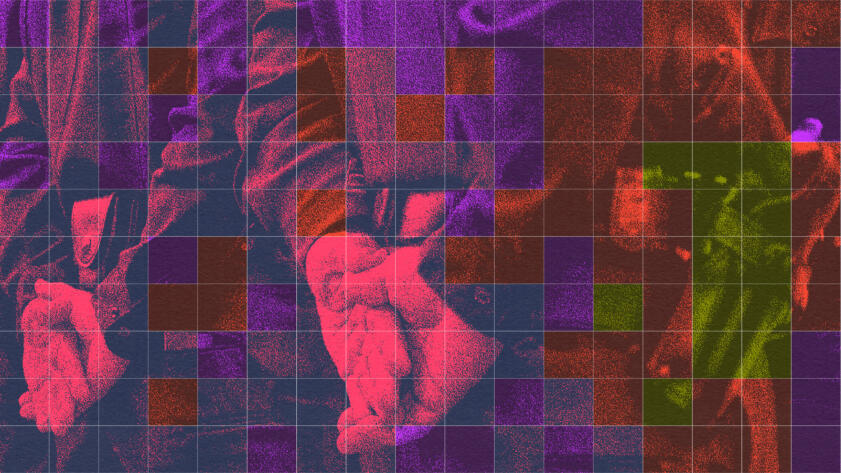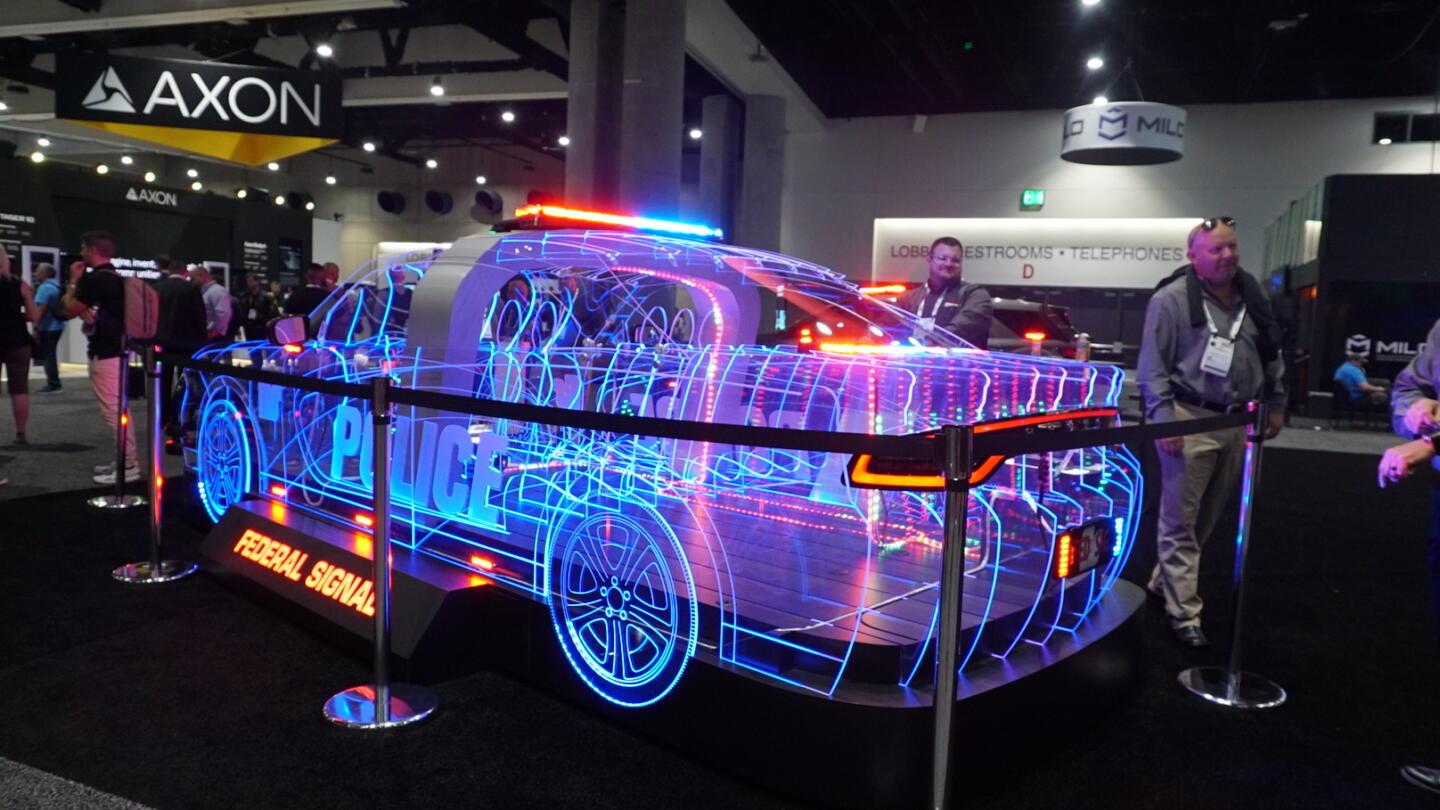Last month, thousands of police descended on San Diego for the annual conference of the International Association of Chiefs of Police. As police leadership from around the world gathered to network and share insights about their work over a long weekend, nearly 700 companies and organizations set up shop in the city convention center’s cavernous exposition hall, pitching their latest products to law enforcement’s top decision-makers.
Many of the big players in policing technology were present: body camera and Taser maker Axon, SoundThinking (formerly ShotSpotter), and Flock Safety, which sells systems that can automatically read license plate numbers and generate data for law enforcement investigations.
But beyond any lucrative contracts that may have come out of the vendor-fest was a clear sense of the kinds of technologies that are attracting cops’ attention. Many of the latest public safety gadgets on display at the conference fit into a few big buckets: artificial intelligence and algorithmic products, policing tools like drones and robots, and enhanced surveillance technologies, such as tracking devices that look exactly like packs of Newport cigarettes or bottles of medication.
Predictably, AI and algorithmic products dominated the sometimes frenzied expo floor — where attendees could go from testing the latest model of Taser, the Taser 10, to participating in a virtual reality simulation where they play an officer encountering a school shooter or patrolling an encampment of unhoused people.
Many AI-powered products claimed the ability to both interpret multiple data feeds and generate investigative insights, like sound-monitoring “aggression detectors” designed for schools or correctional facilities, or voice analysis algorithms that purport to detect fraud risks based on speech. Other tools promised AI-fueled video analysis, including a platform called Truleo that studies body-worn camera footage, which said it can assess an officer’s professionalism by monitoring their use of profanity or noncompliance with department rules.

Axon’s Ethics Board Resigned Over Taser-Armed Drones. Then the Company Bought a Military Drone Maker
The CEO's vision for Taser-equipped drones includes a fictitious scenario in which the technology averts a shooting at a daycare center
Other companies sold less technical tools like flashlights and batons. Similar to the pitches for more complex tools, sales reps made claims around improving safety, accuracy, or efficiency in police work. Twice, for example, vendors selling police batons invoked Rodney King, who was beaten on camera in 1991 by four Los Angeles police officers. The sales pitch for the “Peacekeeper Baton,” which is heavier in the “striking area” than the handle, emphasized that it offered a more “one and done” solution, rather than a prolonged altercation. “No one wants that,” one salesperson said.
During the day, many of the 16,000 attendees — some from Indonesia, Ireland, the Dominican Republic, the United Kingdom, Brazil, the Ivory Coast, Kazakhstan, Haiti, Nigeria, the Bahamas, Saudi Arabia, Japan, Canada, and Jamaica — attended panels on a range of policing topics, including digital evidence management and technology, retail theft, smart cities, and ghost guns. Despite the geographic diversity, most of the presenters and panels were made by and composed of Americans and Europeans, including FBI head Christopher Wray and Interpol Secretary-General Jürgen Stock, who both gave remarks at the conference.
On some evenings, sponsors and vendors hosted various social activities, such as a block party in the city’s Gaslamp Quarter featuring an escape room sponsored by Axon and a cigar-rolling station courtesy of Flock Safety. Scenes from the conference echoed the “Cop Con” episode of the sitcom Brooklyn 99, where the cast attends a similar conference with a sprawling expo and raucous parties.
Surveillance and privacy researchers attended the conference to better understand what’s new in the rapidly shifting realm of police technology. Experts also said some technologies were conspicuously absent at this year’s conference.
“One of the most interesting things is not the technology I saw, but the technology I didn’t see,” said Dave Maass, director of investigations at the nonprofit Electronic Frontier Foundation, who has attended three IACP conferences and presented this year on public records requests. “Up until this [year], face recognition was everywhere. I don’t think I saw one [vendor] on the floor that that was their main product they were pushing.”
“I don’t know why that is,” he added. “I didn’t really see it brought up that often in panels. People just weren’t touching it. And I’m not sure that’s because the technology has become pretty toxic in public discourse, if it’s just not as useful and hasn’t lived up to promises — who knows, but people were not into it.”

Prediction: Bias
Predictive Policing Software Terrible At Predicting Crimes
A software company sold a New Jersey police department an algorithm that was right less than 1% of the time
Instead, machines like drones and police robots were a big focus at the conference, which included multiple panels on drones as public safety “partners” that could respond to calls for service or augment an officer’s situational awareness. One type of drone could be used with a mapping-and-scanning software that could build a three-dimensional model of a scene. Another could be used with an “arm” that could break windows and breach buildings.
Also popular: enhanced surveillance technologies, like automatic license plate readers.
Many of the emerging types of public safety technologies featured at the conference can be used in concert, experts in attendance said.
“One of the things that I saw was a company selling an [automatic license plate recognition] camera that has gunshot detection in it,” said Gabriel Pereira, a researcher at the London School of Economics and Political Science. “For example, if a car passes by that is very loud, that may be doing a race on the street or something like that, they allegedly could detect that with those ALPR cameras.
“We’re seeing the piling-up of different technologies in a way that is even surprising to us researchers,” added Pereira, who is writing a book about ALPR technology.
In another panel, Maass said, the police chief of the Royal Bahamas logged into an online system and pulled up live video from an officer’s body camera on screen for the audience.
“We’d always said that body-worn cameras are just wearable surveillance; they’re turning police into surveillance networks,” Maass said. “And that’s something you can say rhetorically, but … quite literally they are hooking into a surveillance network so that police at headquarters can watch through body-worn cameras in real time. It’s just astounding.”






